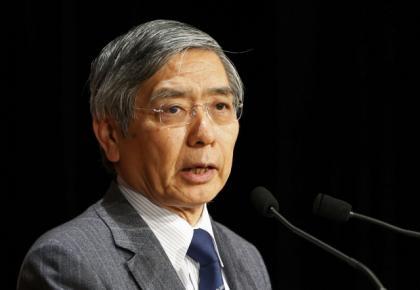BOJ's stance, falling global debt yields support yen
Bareksa • 20 May 2014

Bank of Japan Governor Haruhiko Kuroda speaks during a seminar in Tokyo (REUTERS/Yuya Shino)
The dollar traded at 101.54 yen, a day after falling to 101.10 yen
Bareksa.com - The yen held near a 3 1/2-month high against the dollar and the euro on Tuesday, supported by diminishing expectations of stimulus by the Bank of Japan as well as falling U.S. and European bond yields.
The dollar traded at 101.54 yen, a day after falling to 101.10 yen, its lowest level since early February - briefly breaking below its 200-day moving average at 101.25 yen.
The chart break was a talking point among yen traders given the dollar has not held below that average except for brief forays in October-November last year. The dollar has largely been in a strong position since late 2012 when Japanese Prime Minister Shinzo Abe's embarked on aggressive fiscal and monetary easing to revive growth.
As a result a sustained fall below that mark may portend a turning point in the yen's weakening trend.
"The last few times the dollar fell below the 200-day moving average, its stints have been brief. For now the dollar looks to have hit a technical bottom, but a downward bias will be formed if it closes the next one or two sessions below the moving average," said a trader at a large Japanese bank in Tokyo.
The uptick in the yen also comes at a time of decreasing expectations of near-term monetary easing by the Bank of Japan.
The BOJ is widely expected to keep its policy unchanged at a two-day policy meeting starting on Tuesday, with the market now looking to Kuroda's news conference after the meeting.
"Very few players expect the BOJ to do anything tomorrow, so positioning before the policy meeting has been limited. Many would rather wait and react to what the BOJ has to say after the meeting," the trader at the large Japanese bank said.
Governor Haruhiko Kuroda has stuck to an upbeat assessment on the Japanese economy in recent weeks, dousing immediate easing expectations.
"If Kuroda makes dovish comments tomorrow, then the dollar/yen may manage to stay above the 200-day average. But if he intentionally stresses his optimistic economic views, markets will take it as a sign he accepts a higher yen and a fall in stocks," said Osamu Takashima, head of FX strategy at Citigroup Securities in Tokyo.
The dollar has been facing some pressure of its own from falls in U.S. Treasury yields.
Mixed economic data and a generally dovish outlook from the Federal Reserve have weighed on U.S. bond yields, keeping dollar bulls in check.
On Monday, Dallas Fed President Richard Fisher and San Francisco Fed President John Williams added to the dovish tone.
Fisher, known for his hawkish views on monetary policy, said there have been positive aspects to the Fed's easy policy, while Williams, a dove, acknowledged weakness in the U.S. housing sector.
Williams added that it was not appropriate for the Fed to start raising interest rates until the second half of next year.
The benchmark U.S. 10-year yield, which hit a six-month low of 2.473 percent last week, has stood near that level since then.
The euro also fell to 3 1/2-month low of 138.62 yen on Monday and last fetched 139.23 yen.
Against the dollar, the common currency was steadier at $1.3711, little changed over the past few days, though it was not far from 2 1/2-month lows of $1.3648 hit last Thursday.
The euro has been pressured by soft euro zone growth data published on Thursday and expectations that the European Central Bank will adopt stimulus early next month.
The euro could come under more pressure ahead of potentially destabilising European Parliament elections later this week, where votes for anti-austerity, eurosceptic parties look set to increase.
Yields on Italian and Spanish government bonds rose on Monday, as investors took profits on recent price gains as investors were concerned a rise of eurosceptic forces could thwart reform efforts. (Source : Reuters)